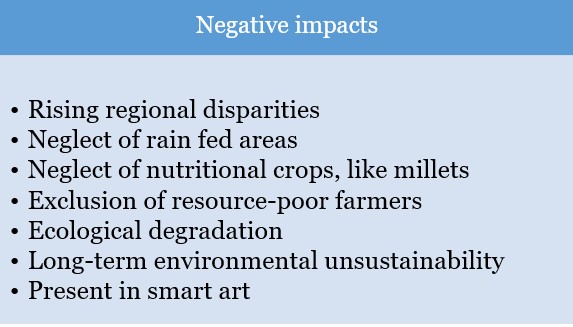Mains: GS III – Indian Economy and issues relating to planning, mobilization of resources, growth, development and employment
Recently, The Government has imposed a cap of 60% on the spending under the Mahatma Gandhi National Rural Employment Guarantee Scheme (MGNREGS).
Agriculture – The science, art, or practice of cultivating the soil, producing crops, and raising livestock and in varying degrees the preparation and marketing of the resulting products
Employment - It remains India’s largest sector for employment, accounting for 46% in 2023-24.
GDP – Contributing only 16% to the country’s GDP.
Gross value added (GVA) - During the last eight years, the real GVA of agriculture has increased by 4.9 %.
Projected growth - The projected growth rate of agriculture in FY 2025 is 4.6% compared to 2.7%in FY 2024.
Dependent on climate - The projections for growth are based on a good Kharif (summer) harvest.
It also depends on an equally positive Rabi (winter) harvest, which is largely dependent on climatic conditions.
Real wages – It have largely remained stagnant.
Workforce – It consists of cultivators and agricultural labourers.
Cultivators, own land or operate land through lease or contracts.
Agricultural labourers work on land owned by others in return of wages, paid in cash or kind.
Acts as a buffer – Rural households went back to agriculture in the absence of other alternatives during the lockdown.
Alternative opportunity – Migrant workers returning to their respective areas also took up agricultural work as a “fall-back” option.
Reliant on investment – Sustained agricultural growth and rise in farmers’ income are dependent on public investment and structural reforms in the sector.
Income – According to NABARD’s All India Rural Financial Inclusion Survey (2021-22).
Diversification of income – Agricultural households have also shown more diversification into other income sources as compared to non-agricultural households.
Rising input costs and uneven distribution of the benefits of the Green Revolution, pushed many rural households to opt for alternative non-farm sources of income.
Hindu rate of growth – India’s economic growth between the 1960 and 1980 has been termed by economist Raj Krishna as the Hindu rate of growth.
Hindu rate of growth refers to the low economic growth that averaged around 4 %.
Slow progress – During the 1960s, the growth rate of agriculture was around 1% annually, which increased slightly to 2.2% between 1968-69 and 1975-76.
Self-sufficiency - The Green Revolution helped the country achieve food sufficiency in food grains like rice and wheat.

|
MNREGA |
|
Insufficient funds – In recent years, the scheme faced issues such as inadequate budget allocation and
Delayed wage disbursement – There has been significant delay in the wages of the workers.
Reduced working days – As of 2018-19, only 7.4% of rural households, on average, availed of 100 days of work.
In 2023-24, an average MGNREGS household worked only for 52 days.
Increase in rural distress – Since the pandemic, there has been a rise in the number of people demanding MGNREGS work.
However, the growing gap between the demand for work and its availability underlines a larger rural distress.
Finding employment since the lockdown has become difficult which further elevates the problem.
Data from the Centre for Monitoring Indian Economy (CMIE) highlights many distress

Impact of green revolution – The technologies introduced to boost agricultural productivity and farmers’ income resulted in less labour intensive agricultural practices.
Creation of linkages – The surplus production created forward linkages that generate demand for goods and services produced by small-scale, labour-intensive rural entities.
They also created backward linkages and spurs demand for agro-processing goods.
Forward linkage is created when the output of one industry becomes the input for another industry, essentially moving "forward" along the production chain
Backward linkage occurs when the production of one industry creates demand for inputs from other industries, essentially moving "backward" along the production chain
Regional inequality – Largely benefitted the states of Punjab, Haryana, and West Bengal
Depend on borrowings – Large number of farmers are increasingly relying on borrowing to manage their agricultural activities.
Hence they shifted to other sort of employments.
Rise in expenditure – Increasing costs of cultivation, including the cost of labour, fertilizers, and machinery dragged people out of agriculture.
Lack of adequate employment – Despite growth in the agricultural sector, rural workers struggle to find adequate employment.
Inadequate policies – Easing credit access, reducing direct taxes (like corporate taxes), and promoting the ease of doing business are insufficient in addressing the basic concerns of job creation and the quality of employment in rural areas.
The fund allocation and implementation of MGNREGA could be strengthened in future policy decisions.
Public investment in agriculture could be scaled up, particularly in areas like irrigation, storage, and climate-resilient farming practices.